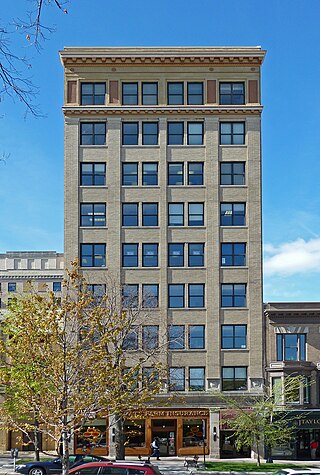Purcell & Elmslie (P&E) was the most widely known iteration of a progressive American architectural practice. P&E was the second most commissioned firm of the Prairie School, after Frank Lloyd Wright. The firm in all iterations was active from 1907 to 1921, with their most famous work being done between 1913 and 1921.

Charles L. Thompson and associates is an architectural group that was established in Arkansas since the late 1800s. It is now known as Cromwell Architects Engineers, Inc.. This article is about Thompson and associates' work as part of one architectural group, and its predecessor and descendant firms, including under names Charles L. Thompson,Thompson & Harding,Sanders & Ginocchio, and Thompson, Sanders and Ginocchio.

Proudfoot & Bird was an American architectural firm that designed many buildings throughout the Midwest region of the United States. Originally established in 1882, it remains active through its several successors, and since 2017 has been known as BBS Architects | Engineers.
Albert Anthony Ten Eyck Brown (1878–1940) was an architect active in Atlanta, Georgia and other areas. Brown was born in Albany, New York. He studied at the New York Academy of Design.

Keene & Simpson was an American architectural firm based in Kansas City, Missouri, and in practice from 1909 until 1980. The named partners were architects Arthur Samuel Keene FAIA (1875–1966) and Leslie Butler Simpson AIA (1885–1961). In 1955 it became Keene & Simpson & Murphy with the addition of John Thomas Murphy FAIA (1913–1999), who managed the firm until his retirement in 1980.

William Dubois (1879–1953) was an American architect and politician. He was a prolific architect in Wyoming and nearby states, and served five terms in both houses of the Wyoming Legislature.

Ira L. Rush (1890-1949) was an American architect in practice in Minot, North Dakota from 1915 until his death in 1949.

William F. Kurke (1889–1965) was a prolific architect in North Dakota.

The Bismarck Tribune Building on N. 4th St. in Bismarck, North Dakota was designed by architect George H. Shanley and was built in 1920.

George H. Shanley was an architect of Great Falls, Montana.

The Bismarck Civic Auditorium on North 6th Street in Bismarck, North Dakota, was built in 1914. It has also been known as City Auditorium and, after 1989, the Belle Mehus Civic Auditorium. It was listed on the National Register of Historic Places in 1976.

The Downtown Bismarck Historic District is a 40-acre (16 ha) historic district in Bismarck, North Dakota that was listed on the National Register of Historic Places in 2001. It includes work by architect Arthur Van Horn and others. The listing included 40 contributing buildings.

Wallace L. Dow (1844-1911), often known as W. L. Dow, was an architect of Sioux Falls, South Dakota. He has been referred to as the "Builder on the Prairie" and was "considered the premier architect of South Dakota in the late 19th century."

Frederick W. Keith (1879-1954) was an American architect, beginning his career in Indianola, Iowa but gaining prominence while practicing in Grand Forks, Bismarck, and Fargo, North Dakota. After a successful independent practice, he joined forces with William F. Kurke as Keith & Kurke.

Law, Law & Potter was an architecture firm in Madison, Wisconsin; Potter Lawson, Inc. is its modern-day successor. Some of its buildings are listed on the U.S. National Register of Historic Places for their architecture. The firm was Madison's largest and "arguably most important" architectural firm in the 1920s and 1930s.

Old Mandan High School, superseded by a more modern Mandan High School in 1958, in Mandan, North Dakota, was listed on the National Register of Historic Places in 2017. After it served as high school it was Mandan Junior High.

Gilbert R. Horton FAIA (1888–1985) was an American architect in practice in Jamestown, North Dakota, from 1913 until 1980.

Lorentz Schmidt was a prominent architect in Kansas. He practiced in Wichita, Kansas from 1915 until his death in 1952.

Robert A. Ritterbush FAIA (1891–1980) was an American architect in practice in Bismarck, North Dakota, from 1920 until 1967.

Truman I. Lacey (1834–1914) was an American architect in practice in Binghamton, New York from 1872 until 1914.



















